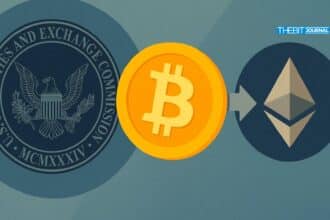SecondSwap, a next-generation decentralized exchange (DEX) for secondary token markets, has officially launched its Ethereum mainnet, offering a new approach to trading locked and illiquid assets. The platform aims to eliminate intermediaries and create a transparent and efficient market where vested tokens can be traded before their release schedules expire.

With its proprietary liquidity routing algorithm, SecondSwap ensures optimized trade execution while minimizing price slippage, creating a secure and scalable trading experience for both buyers and sellers. Founder Kanny Lee has revealed that SecondSwap’s next milestone is an expansion to Solana, a move expected to unlock over $500 million in trading volume by activating just 10% of dormant liquidity in the network.
“Locked token liquidity represents billions of dollars of untapped value. On Solana alone, activating even a fraction of dormant liquidity could inject over $500 million in actionable volume,” Lee stated.
Revolutionizing Locked Token Markets With a Decentralized Model
Traditionally, token holders faced major challenges when trying to liquidate vested assets before the unlock date. Centralized solutions often lacked transparency, forcing traders to rely on private deals with questionable security.
- SecondSwap introduces a decentralized, order book-style exchange that provides:
Real-time buy and sell order visibility for enhanced price discovery. - Market depth and liquidity profiling, reducing unfair token pricing.
- Seamless wallet integration, ensuring proof of control for sellers and funds verification for buyers.
According to Lee, this approach offers a more trustworthy and open marketplace, transforming how locked tokens are traded.
“By introducing a decentralized order book-style exchange, we are bringing transparency to token secondary markets,” Lee explained.

How SecondSwap’s Bid Campaign Boosts Liquidity
To incentivize adoption and improve price discovery, SecondSwap has launched a bid campaign, allowing traders to:
- Set their own price targets for locked tokens.
- Automatically match orders once the buy/sell flow is enabled.
- Receive notifications when their preferred assets become available.
This system enables early liquidity for sellers while allowing buyers to acquire assets at discounted rates, ensuring a more efficient market for both parties.
By integrating proof-of-control verification for sellers and proof-of-funds validation for buyers, the platform mitigates counterparty risks, making it a secure alternative to traditional OTC deals.
Solana Expansion: Unlocking a $500M Liquidity Opportunity
Following the successful Ethereum launch, SecondSwap’s next major move is integrating with Solana. Lee emphasized that Solana’s ecosystem holds massive untapped liquidity, with thousands of projects holding locked tokens that currently lack an efficient market.
“When coupled with the impact that SecondSwap’s vesting mechanism can offer memecoins—to reduce circulating supply—the Solana partnership will continue to flourish and benefit the wider market,” Lee added.
Why Solana?
- Faster and cheaper transactions—ideal for high-volume trading.
- Deep liquidity pools with growing institutional interest.
- Expanding the memecoin ecosystem that can benefit from token vesting solutions.
SecondSwap’s entry into Solana is expected to provide a structured approach to vested token trading, benefiting both projects and traders seeking early liquidity.

Conclusion: SecondSwap’s Vision for the Future of Secondary Token Markets
With its Ethereum mainnet now live, SecondSwap is positioned to become a leader in the secondary token trading industry. The project’s decentralized exchange model, transparent order book system, and liquidity routing algorithm solve a major inefficiency in crypto markets—allowing locked tokens to be fairly and securely traded before their official unlock dates.
The upcoming Solana expansion could be a game-changer, unlocking hundreds of millions in previously inaccessible liquidity while supporting the growing demand for vesting mechanisms in the memecoin sector. If successful, SecondSwap could redefine the landscape of token trading, establishing itself as the go-to DEX for secondary markets.
The BIT Journal is available around the clock, providing you with updated information about the state of the crypto world. Follow us on Twitter and LinkedIn, and join our Telegram channel.
FAQs
1. What is SecondSwap?
SecondSwap is a decentralized exchange (DEX) designed to provide liquidity for locked and vested tokens, allowing them to be traded before their release schedules expire.
2. How does SecondSwap reduce price slippage?
The platform uses a liquidity routing algorithm that optimizes trade execution, ensuring minimal price slippage and fair price discovery for both buyers and sellers.
3. Why is SecondSwap expanding to Solana?
Solana’s locked token market holds hundreds of millions in dormant liquidity. SecondSwap’s expansion aims to activate at least $500M in trading volume by providing a structured marketplace.
4. How does the bid campaign improve liquidity?
Traders can set custom price targets for locked tokens, enabling efficient price discovery and order matching, making buying and selling vested assets easier.
Glossary
Liquidity Routing Algorithm – A system that optimizes trade execution, reducing price slippage and enhancing market efficiency.
Order Book Exchange – A trading model where buy and sell orders are publicly displayed, ensuring transparent price discovery.
Locked Tokens – Tokens that are under vesting schedules and cannot be freely traded until their release conditions are met.
Vesting Mechanism – A process that gradually unlocks tokens over time, often used to prevent early investor sell-offs.





























